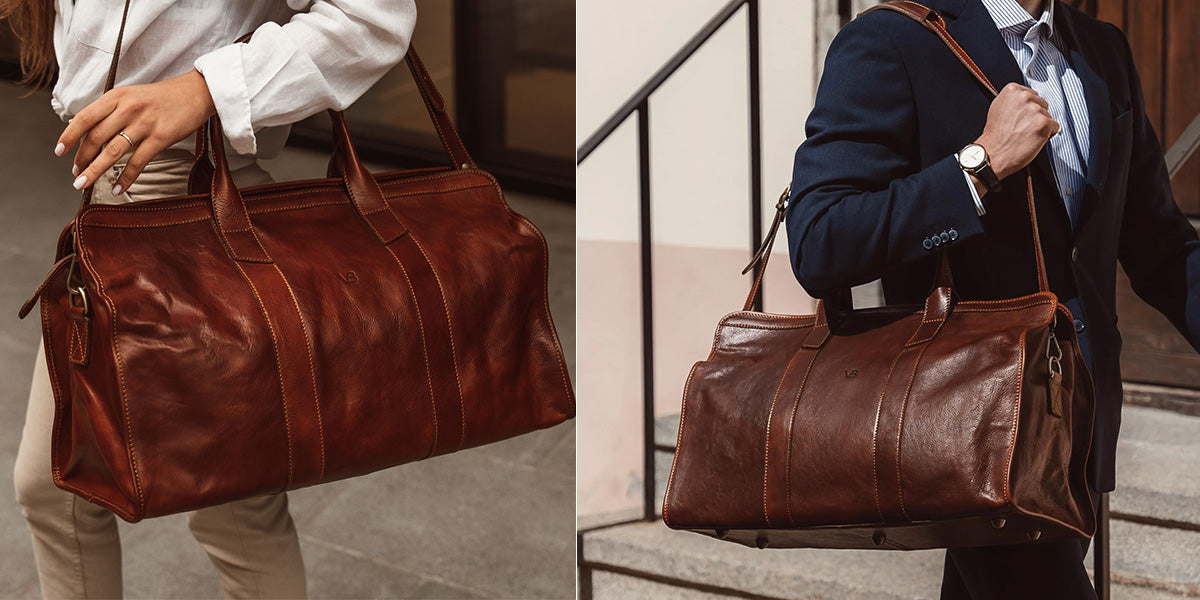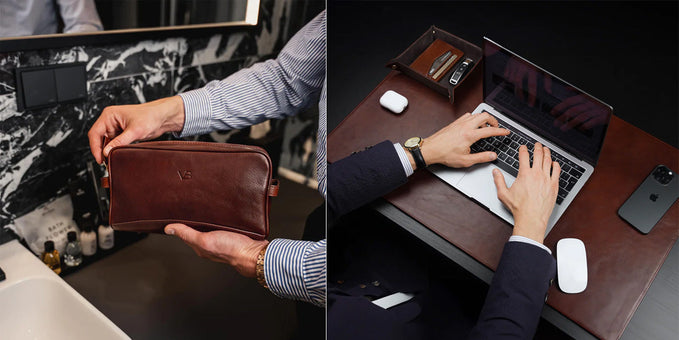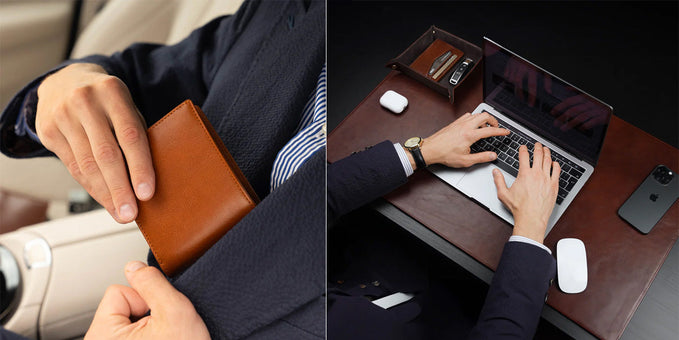How To Dye Leather Properly: Simple DIY Guide

Changing the color of your leather is simple with our leather dyeing guide.
Learn the best ways to dye leather, and the common problems to avoid.
Equipment List: What You Need To Dye Leather
If you want to dye leather properly, you’ll need access to a well-ventilated space alongside numerous materials. These materials include:
- Leather deglazer: This cleans the leather and prepares it for the dyeing process.
- Spray bottle: Once you’ve deglazed the leather, you’ll need to gently spray it with water so it can absorb your first coat of dye.
- Paint brush: You’ll need this to apply the dye. Alternatively, you can use a wool dauber.
- Leather dye: The dye you opt for will determine the color of the leather as well as its quality and feel.
- Scrap rag: Use an old scrap piece of cloth to help you deal with spills and excess dye.
- Gloves: Dyeing jobs can get messy, so you’ll need to protect your hands and forearms. Dishwashing gloves should be effective.
Your workspace should be well-ventilated and protected. The ventilation is needed because the dye can release fumes that can be dangerous if you breathe them in. If you’re indoors, open your windows and switch on a fan.
If you’re working outdoors, do so on a dry day and keep out of direct sunlight.
You can keep your workspace clean by using a drop cloth or by taping down a large trash bag.
Choosing Your Dye Finish
The kind of leather you’re working with determines which is the best dye for your needs when you want to achieve the right finish and color.
Let’s examine some of the most popular options right now.
Shoe polish

This works best as a temporary kind of dye. This is because the polish won’t penetrate the fibers of the leather.
However, it’s quick and easy to apply it.
Alcohol-based leather dyes
These dyes do penetrate the surface of the leather and can create long-lasting vivid colors.
Do be aware that alcohol can strip the moisture from the leather and make it stiff. This is why you may require a leather conditioner or finisher to restore it.
The sun

This gives you a natural option for dying leather. Leave your veg-tanned leather out in the sun to darken its hue. You can expect this process to take a minimum of an hour.
The darker you want your leather to be, the longer you should leave it out for. UV rays from the sun will turn lighter leather into a dark brown over time.
Oil-based leather dyes
These dyes don’t strip the leather of liquids. They cut through the surface of your leather, coloring your fibers to a rich saturation.
These dyes are best used with full and top grain leather that don’t have surface finishes as it means the fibers will dry more quickly.
Water-based leather dyes
These dyes don’t have as many toxins as other dyes, but they do produce more muted colors. The dyes should ensure your leather is supple.
Resolene
Resolene or acrylic dye can be applied in thin layers as a leather finish. Once the drying process is complete, you can expect the thin layers of acrylic to harden into a protective surface that’s also solid and shiny.
This can work well with corrected grain leather that’s had its fibers sanded down. There are various colors and finishes available for resolene, which means it’s an incredibly versatile option.
Resin
Leather finishers manufactured from natural resin give you a subtler, softer finish and good protection from dirt.
Resin-based finishers aren’t water-resistant and can be highly effective.
Preparing the leather for dyeing

Here’s what you need to do whilst you’re prepping your leather for the dyeing process.
- Use gloves: Though this may seem an obvious step, many people have neglected to use gloves during this process before quickly regretting it.
- Ventilate your space: Fumes from oil dyes can be dangerous. One step you can take to ventilate your room is to place a fan by the window.
- Choose the right leather: It’s possible to dye any un-dyed vegetable tanned leather. If you do try to dye pre-dyed vegetable tanned leather, note that the waxes on the top of finished leather will stop the dye from penetrating the leather well.
- Wipe the leather down: Wipe your leather down quickly with a dry rag before you start dyeing it. This will enable you to create an even coat. Some people use deglazers on the leather to remove any oils that have ended up on the material.
- Sand the leather down: By lightly sanding the leather surface before you start dyeing, you can enhance the way the dye is absorbed.
- Conditioning the leather: You can stop the leather from drying out by applying a leather conditioner or moisturizer after deglazing and before dyeing.
- Cut your dyes: When you’re working with an oil-based dye, try to use a dye that’s compatible with oil-based products. If you’re using a water-based dye, look for a product that’s specifically formulated for water-based applications.
Make sure you’re diluting the dye effectively. Applying several coats of dye can give you a more polished appearance.
However, if you achieve the color you desire in the first application, adding more dye won’t help you achieve color uniformity. It can actually create a marbled effect.
Remember that adding multiple applications of water-based dyes can cause the leather to dry out over time. You could apply a special oil to restore moisture to your leather after you have dyed it with a water-based product.
Related pages:
- Repair cat scratches on leather
- Remove water stains from leather
- Clean leather wallet & remove stains/smells
- Remove ink from leather
- Get smell out of leather
- Remove stains from leather shoes
- Clean suede leather bag
How to dye your leather properly

-
Prepare your workstation:
You need to get your workstation ready before you get started. If you’re working indoors, do so at a large table.
-
Open your windows and switch on a fan
This will dilute the strength of the fumes from the dye. Try to maintain a temperature of around 70 degrees Fahrenheit, and open a large trash bag to lay on your surface for protection.
-
If you’re working outdoors
Do so on a space that isn’t too windy and work in the shade. You can place old towels on the floor to catch spills and wear gloves.
-
Apply the deglazer:
Use a clean cloth to apply the deglazer. This removes the seal from your leather so the fibers can absorb your dye more effectively. If you’re working with leather shoes, take the laces out first and put some balled-up paper inside to keep them dry.
-
Spray the leather with water:
You need to ensure the surface of the leather is gently dampened so the material can absorb the dye easily.
-
Start your first coat:
Acquire a paint brush, lightly add some dye, and start painting the edges of the leather material. Hiding brush strokes can be difficult, so use a sponge or a cotton ball to fill in the remainder of the surface. Add dye to your cotton balls and apply the dye in a circular motion.
-
Different techniques can deliver unique effects:
Gradient effects can be created when you apply your dye with a sponge using a sweeping motion. Mixing dye colors together enables you to make bespoke shades and create fun color variations on your leather.
-
Allow your leather to completely dry:
This will take a full day.
-
Add more thin coats:
When the leather has dried completely, you can add an extra thin layer of dye. This ensures you have a uniform dye job. Add a minimum of three layers. You may need to add more than this to achieve the color you desire.
-
Buff your leather:
Once the dyeing process is complete, a leather finisher or sheen can be used to create a shiny finish. You can also clean and smoothen out your surface by buffing it with a cloth. Allow your leather to dry, clean the work surface, then start enjoying your freshly dyed material.
Related articles:
- How to reform a leather bag
- How to maintain leather bags
- Repair cracked leather
- Wet leather
- How to clean leather bag
- How to restore faded leather bag
- How to stretch leather
- How to shrink leather
- How to soften leather
- How to wash leather
- How to fix faux leather peeling
- Bonded Leather Peeling
Finishing and protecting your leather
You can apply a sealant or leather finish after dyeing. This can enhance the color and protect your leather from wear and tear.
Leather finishes come in a number of forms, including waxes, creams, and sprays. Each of these comes with its own level of shine and application method.
Interested in a new leather bag instead? Check out the full grain leather range at Vonbaer.com, including this fantastic leather travel bag:
Troubleshooting
If you make a mistake or spot uneven coloring, a leather color remover can be used to correct this. You may also be able to use a bleach product that’s specifically been designed for use with leather.
Remember that dyeing leather is a skill that you’re likely to get better at with practice. This is why it's so important to experiment on scrap leather or a small inconspicuous area before you embark on a larger project.
Key advice for dyeing leather
The following tips can help you make the dyeing process simpler and more effective.
- Gain access to a wide range of tools for applying your dye. Cotton balls make it easier to get into smaller areas, sprayers help you to blend colors, and sponges can give you more texture.
- It’s also wise to sample your dye color. The final shade of the dyed leather won’t be identical to the color of the dye inside the bottle. This is why you need to experiment with a small sample to see how the color looks on your material. Mixing colors can help you achieve the look you desire.
- Dipping can be a quick and easier technique. If you want to dip dye your leather, you’ll need to buy more dye. Pour your dye into an old bowl or container and ensure enough dye is available to submerge the item that you want to dye. Dip it in for a few moments then remove and let it dry overnight. Dipping is a highly effective method for achieving an even coating.
Read this next:
- Bleach On Leather
- How To Fix Scuffed Leather
- How To Rehydrate Leather
- How To Stiffen Leather
- How To Restore Leather
- Leather
- Leather guide for beginners
- Where does leather come from
- Leather grades
- How is leather made
- How to tell if leather is real
- What is Real Leather
Conclusion
We hope you enjoyed our article on how to dye leather.
If you have any questions or comments, contact us at info@vonbaer.com, or leave them in the comments.
Want to read more? Check out our Leather pages.
Related articles:
- How To Clean Mold off Leather
- How To Clean Faux Leather
- How To Repair Leather
- Leather Burning
- Best Leather Cleaners & Conditioners
- How To Get Sharpie off Leather
- How To Clean Suede
- DIY Leather Conditioner
- Wet Molding Leather
- Best Leather Oil
- How To Clean White Leather
- How To Get Oil Out of Leather
- Clean Leather Car Seats

Author: Albert Varkki
Albert Varkki is the co-founder of Von Baer. He understands leather products as a consumer, supplier, and a manufacturer, helping you with the inside knowledge you need, to choose the perfect leather product for you.
We strive for the highest editorial standards, and to only publish accurate information on our website.
Leave a Comment
Your email address will not be published.






